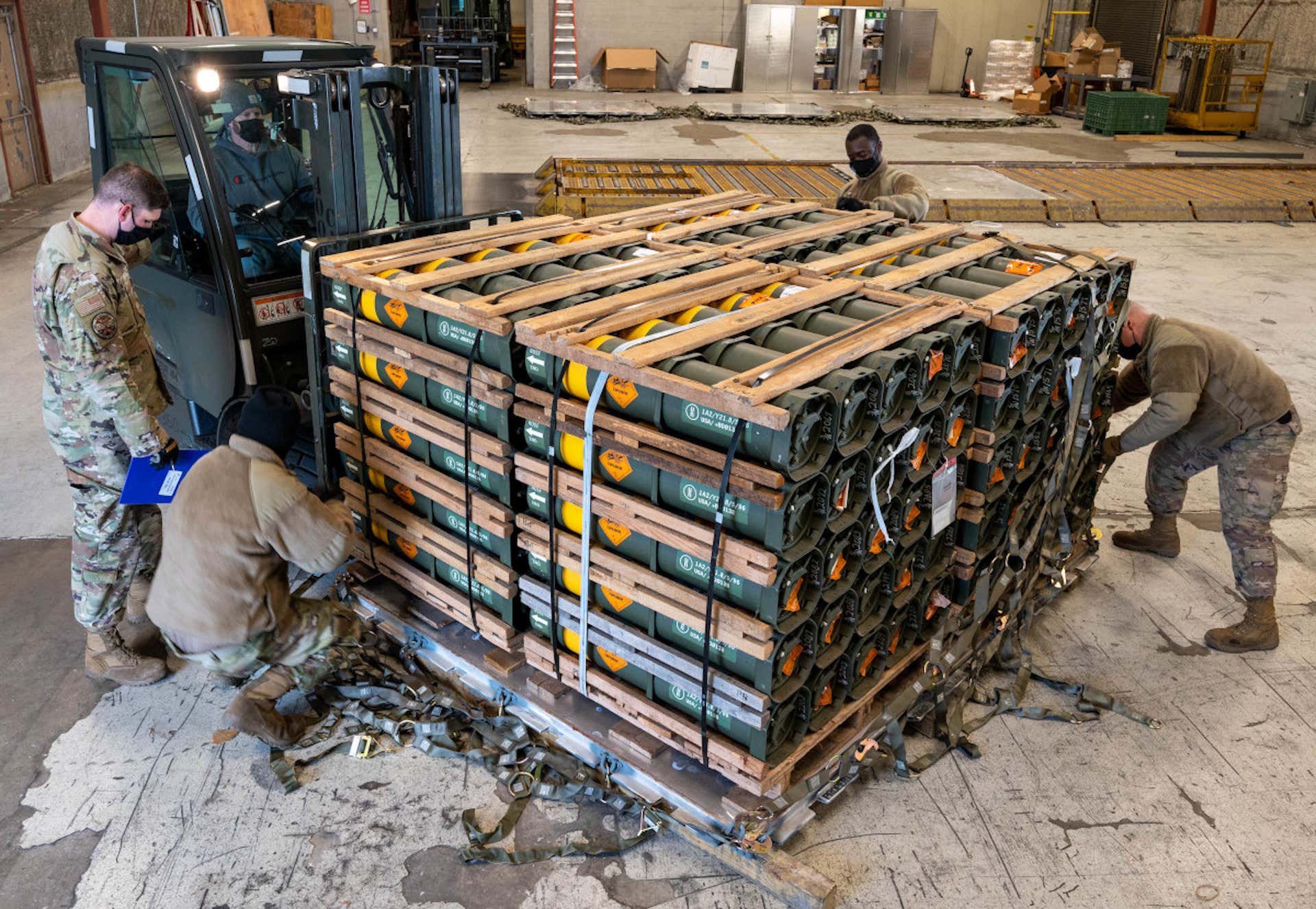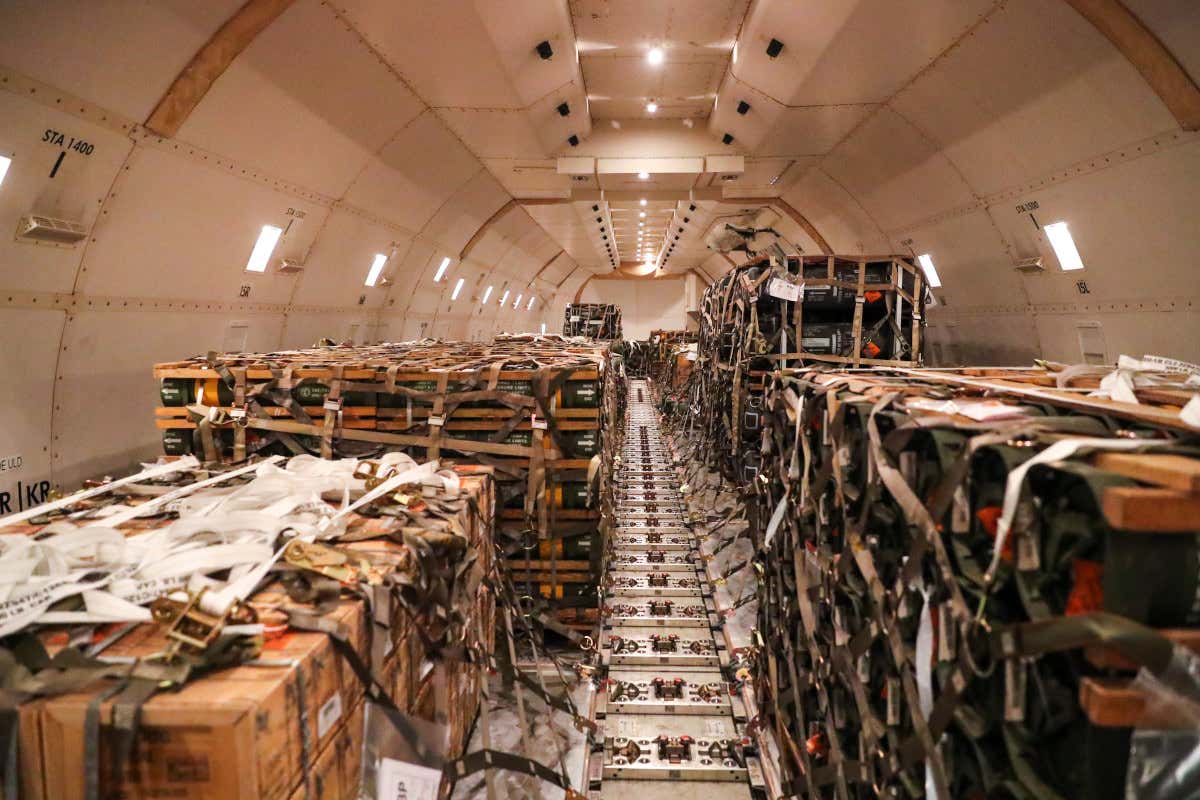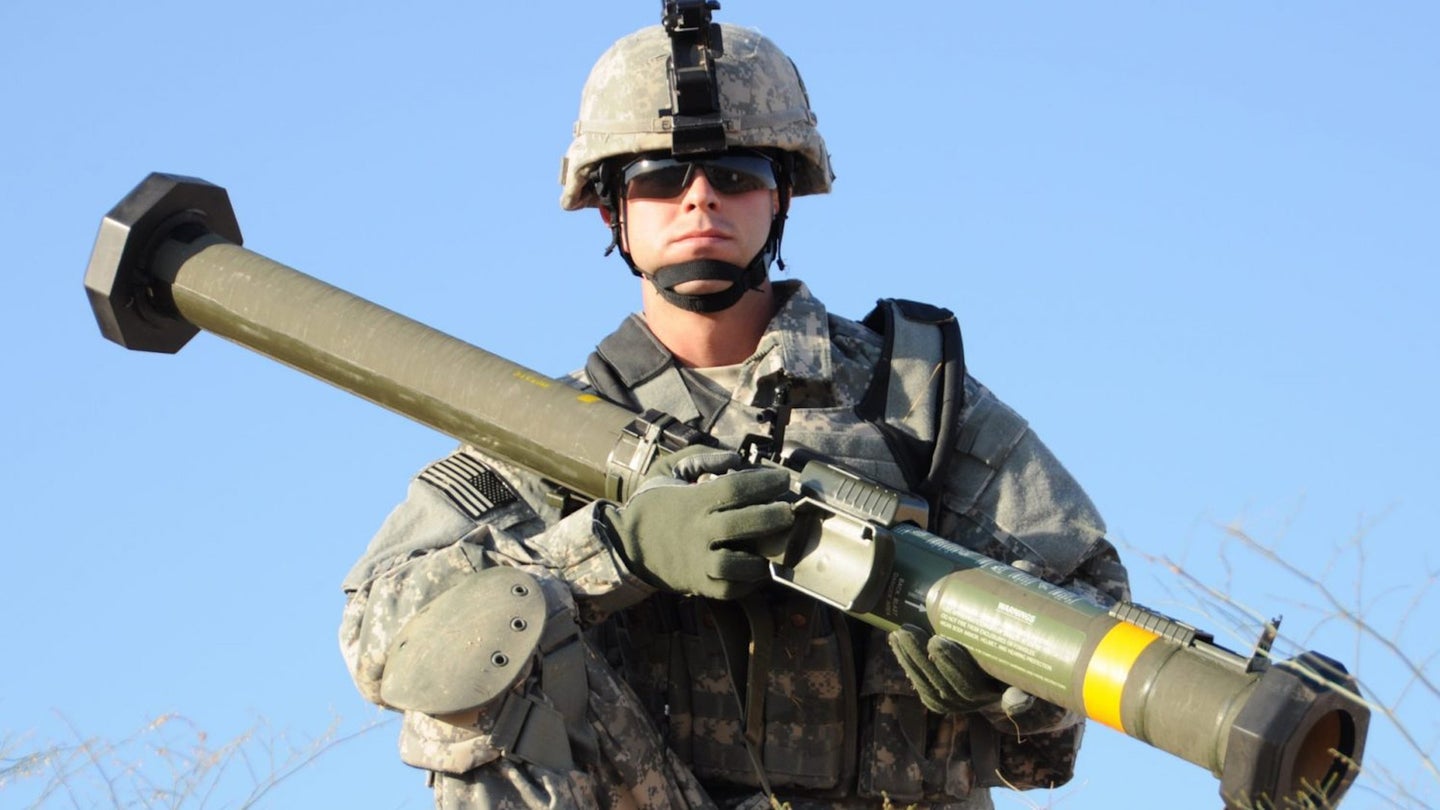January 26, 2022
BY STEVE SWEENEY
PEOPLES WORLD
CPUSA

Speaker of the House Nancy Pelosi, D-Calif., has fast-tracked Ukrainian weapons funding legislation. | Tom Williams / CQ Roll Call via AP
U.S. officials are planning to rush through a major bill that will dramatically bolster weapons allocations for Ukraine and increase funding for anti-Russian propaganda and intelligence, it was announced on Tuesday.
House Speaker Nancy Pelosi said she was fast-tracking the bill, called the “Defending Ukraine Sovereignty Act of 2022,” straight to the House of Representatives. It will see $500 million from the Foreign Military Financing program sent to Ukraine for 2022.
The bill could be voted on as early as next week.
The legislation would give Ukraine priority for excess defense equipment transfer and aid the country’s cyber defense, paving the way for U.S. sanctions in the event of any cyber attack.
Funds would also be spent on anti-Russian propaganda channeled through media outlets, including the CIA-funded Radio Free Europe/Radio Liberty, which was established during the Cold War as an explicitly anti-communist news organization pumping propaganda into the Soviet-aligned states of Eastern Europe.
The bill also authorizes sanctions if President Joe Biden believes Russia has engaged in a “significant escalation in hostilities.” It could see Russian President Vladimir Putin targeted, along with senior government and military officials.
Russian financial institutions, energy producers, and those involved in the Nord Stream 2 pipeline project, which some say is one of the reasons for the U.S. drive to war, would also be threatened.
The European Union and NATO have joined Washington in its aggressive drive to war with Russia, ratcheting up the pressure on a number of fronts.
The U.S. has delivered 90 tons of “lethal aid” as weapons flow into Ukraine while mobilizing war ships to the Black Sea and a surge in troops encircling Russia.
At the same time, a propaganda war waged through Western mainstream media has sought to portray Russia as the aggressor, despite Moscow’s insistence that it has no plans for military intervention in Ukraine.
Much of this has been dismissed as “Western hysteria” by Russia, which has accused intelligence services of running a “psy-ops” campaign to soften public opinion for war.
On Tuesday, U.S. State Department spokesman Ned Price said that Ukrainian officials had been informed and explicitly involved in its written response to Russia’s proposals on security guarantees.
He said that any Russian incursion would be met with “a swift, severe, and united response” from the U.S. and its allies.
Morning Star
READ OTHER UKRAINE COVERAGE:
> The West, not Russia, is responsible for the war danger in Ukraine
> Biden and NATO raise the stakes in deadly Ukraine war gamble
> Who is invading whom? U.S. forces already in Eastern Europe

Speaker of the House Nancy Pelosi, D-Calif., has fast-tracked Ukrainian weapons funding legislation. | Tom Williams / CQ Roll Call via AP
U.S. officials are planning to rush through a major bill that will dramatically bolster weapons allocations for Ukraine and increase funding for anti-Russian propaganda and intelligence, it was announced on Tuesday.
House Speaker Nancy Pelosi said she was fast-tracking the bill, called the “Defending Ukraine Sovereignty Act of 2022,” straight to the House of Representatives. It will see $500 million from the Foreign Military Financing program sent to Ukraine for 2022.
The bill could be voted on as early as next week.
The legislation would give Ukraine priority for excess defense equipment transfer and aid the country’s cyber defense, paving the way for U.S. sanctions in the event of any cyber attack.
Funds would also be spent on anti-Russian propaganda channeled through media outlets, including the CIA-funded Radio Free Europe/Radio Liberty, which was established during the Cold War as an explicitly anti-communist news organization pumping propaganda into the Soviet-aligned states of Eastern Europe.
The bill also authorizes sanctions if President Joe Biden believes Russia has engaged in a “significant escalation in hostilities.” It could see Russian President Vladimir Putin targeted, along with senior government and military officials.
Russian financial institutions, energy producers, and those involved in the Nord Stream 2 pipeline project, which some say is one of the reasons for the U.S. drive to war, would also be threatened.
The European Union and NATO have joined Washington in its aggressive drive to war with Russia, ratcheting up the pressure on a number of fronts.
The U.S. has delivered 90 tons of “lethal aid” as weapons flow into Ukraine while mobilizing war ships to the Black Sea and a surge in troops encircling Russia.
At the same time, a propaganda war waged through Western mainstream media has sought to portray Russia as the aggressor, despite Moscow’s insistence that it has no plans for military intervention in Ukraine.
Much of this has been dismissed as “Western hysteria” by Russia, which has accused intelligence services of running a “psy-ops” campaign to soften public opinion for war.
On Tuesday, U.S. State Department spokesman Ned Price said that Ukrainian officials had been informed and explicitly involved in its written response to Russia’s proposals on security guarantees.
He said that any Russian incursion would be met with “a swift, severe, and united response” from the U.S. and its allies.
Morning Star
READ OTHER UKRAINE COVERAGE:
> The West, not Russia, is responsible for the war danger in Ukraine
> Biden and NATO raise the stakes in deadly Ukraine war gamble
> Who is invading whom? U.S. forces already in Eastern Europe
Here's What Those 'Bunker-Defeat' Rockets The U.S. Sent To Ukraine Are Actually Capable Of
The M141 Bunker Defeat Munition is a relatively obscure weapon in the U.S. military's arsenal with capabilities beyond what's it name might suggest.
The U.S. government, among others, has been stepping up deliveries of weapons and other military aid to Ukraine amid increasingly worrisome signs that Russia may be about to launch a new invasion of that country. The spotlight has primarily been on shipments of guided anti-tank missiles, especially U.S.-made Javelins and British-supplied NLAWs. Announcements that Latvian and Lithuanian authorities plan to send American-produced Stinger shoulder-fired surface-to-air missiles have also drawn attention, but to a lesser degree. However, the U.S. military has recently highlighted the transfer of pallet loads of a more obscure weapon system with an unusual name that doesn't necessarily reflect its full capabilities: the M141 Bunker Defeat Munition.
The U.S. Air Force first released pictures showing dozens of M141s being prepared for shipment to Ukraine at Dover Air Force Base in Delaware on Jan. 22, 2022. Those weapons, along with Javelins and small arms ammunition, arrived at Boryspil International Airport outside of Kyiv yesterday onboard a National Airlines Boeing 747 aircraft flying under a contract with U.S. Transportation Command (TRANSCOM).

USAF
A pallet of M141 Bunker Defeat Munitions bound for Ukraine at Dover Air Force Base in Delaware on Jan. 21, 2022.

US DEPARTMENT OF STATE
M141s, along with Javelins and small arms ammunition, seen inside a National Airlines Boeing 747 after it arrived at Boryspil International Airport earlier today.

US DEPARTMENT OF STATE
The National Airlines 747 carrying the military aid for Ukraine at Boryspil.
The M141 is a very different weapon from the Javelin, an advanced guided anti-tank missile that has become a hallmark of U.S. military assistance to Ukraine and that you can read more about here. The Bunker Defeat Munition (BDM) is a disposable single-shot launcher preloaded with an unguided 83mm rocket-propelled projectile designed to engage targets at relatively short ranges.
Development of what was originally known as the Shoulder-Launched Multipurpose Assault Weapon-Disposable (SMAW-D) started in the 1990s in response to requirements from the U.S. Army. The service was primarily looking for a weapon that would give small units an additional tool for dealing with enemy fortifications on the battlefield, such as pillbox-type concrete bunkers and earthen berms.
McDonnell Douglas initially lead the project, before that company merged with Boeing in 1997. Talley Defense Systems, now a U.S.-based division of Norwegian defense contractor Nammo, subsequently acquired the design. The SMAW-D beat out a competing design based on the Swedish AT-4, a disposable single-shot anti-tank weapon that is also in Army inventory. The service took the first deliveries of what it subsequently designated the M141 in 1999.
M141 is derived from Mk 153 Shoulder-Launched Multipurpose Assault Weapon (SMAW), a reloadable shoulder-fired weapon that McDonnell Douglas developed from the Israeli-designed B-300 for the U.S. Marine Corps in the 1980s. The BDM fires a so-called high-explosive dual-purpose (HEDP) round that is similar to the one available for the SMAW, but with a redesigned rocket motor that reduces its range. The M141 has an effective firing range of up to 250 meters, while the latest versions of the SMAW can reliably engage threats out to 500 meters.
Overall, the BDM is more akin to the most modern variants of the venerable M72 Light Anti-Tank Weapon (LAW), a disposable, single-shot, shoulder-fired launcher pre-loaded with one of a number of types of rockets, including an anti-structure type. For added context, the most recent versions of the shoulder-fired Javelin missile have an effective range of up to 4,000 meters.
However, the M141 definitely still has its uses and could be a handy addition to Ukraine's arsenal. While the weapon was designed to engage enemy fortifications, its HEDP round can be employed against other kinds of structures and fortified positions. For instance, in the early phases of U.S. operations in Afghanistan following the 9/11 terrorist attacks, American troops used BDMs to collapse caves that Taliban militants and Al Qaeda terrorists were using as fighting positions.
BDMs can be used to blast holes in walls and otherwise breach obstacles, creating alternate pathways around the battlefield for friendly forces, as well. These weapons also have a secondary capability against light armored and unarmored vehicles and could be used to destroy caches of ammunition, fuel, and other similar materiel.
For Ukraine's military, M141s could give small units additional immediate firepower, especially against troops and light vehicles in urban areas that might be using structures for cover. BDMs might be useful for groups ambushing convoys of unarmored support and supply vehicles, or conducting raids against enemy encampments, missions that Ukrainian troops might find themselves increasingly engaged in should Russian forces push deep into the country's territory. It is important to note that this weapon does have a significant backblast while firing, which precludes it from being employed from inside confined spaces, such as a room inside a building, forcing the user to expose themselves at least to some degree.
Beyond their utility against various different target sets, the M141s have the benefit of being easier to train personnel to use compared to more complex guided missile systems, such as Javelin. This relative ease of use also opens up the possibility of distributing them on a wider basis and utilizing them, where appropriate, in lieu of missiles, helping to preserve stocks of those weapons for higher-priority targets.
Regardless of how Ukraine might issue its new M141s and employ them, the most important thing is that, despite their name, they are not limited to engaging bunkers and similar fortifications. While the BDM is in no way a substitute for anti-tank guided missiles, they are still very much multi-purpose weapons that could give even small continents of Ukrainian troops additional capabilities and capacity to engage a variety of targets in any future conflict.
Contact the author: joe@thedrive.com
The M141 Bunker Defeat Munition is a relatively obscure weapon in the U.S. military's arsenal with capabilities beyond what's it name might suggest.
JANUARY 26, 2022
THE WAR ZONE

THE WAR ZONE

The U.S. government, among others, has been stepping up deliveries of weapons and other military aid to Ukraine amid increasingly worrisome signs that Russia may be about to launch a new invasion of that country. The spotlight has primarily been on shipments of guided anti-tank missiles, especially U.S.-made Javelins and British-supplied NLAWs. Announcements that Latvian and Lithuanian authorities plan to send American-produced Stinger shoulder-fired surface-to-air missiles have also drawn attention, but to a lesser degree. However, the U.S. military has recently highlighted the transfer of pallet loads of a more obscure weapon system with an unusual name that doesn't necessarily reflect its full capabilities: the M141 Bunker Defeat Munition.
The U.S. Air Force first released pictures showing dozens of M141s being prepared for shipment to Ukraine at Dover Air Force Base in Delaware on Jan. 22, 2022. Those weapons, along with Javelins and small arms ammunition, arrived at Boryspil International Airport outside of Kyiv yesterday onboard a National Airlines Boeing 747 aircraft flying under a contract with U.S. Transportation Command (TRANSCOM).

USAF
A pallet of M141 Bunker Defeat Munitions bound for Ukraine at Dover Air Force Base in Delaware on Jan. 21, 2022.

US DEPARTMENT OF STATE
M141s, along with Javelins and small arms ammunition, seen inside a National Airlines Boeing 747 after it arrived at Boryspil International Airport earlier today.

US DEPARTMENT OF STATE
The National Airlines 747 carrying the military aid for Ukraine at Boryspil.
The M141 is a very different weapon from the Javelin, an advanced guided anti-tank missile that has become a hallmark of U.S. military assistance to Ukraine and that you can read more about here. The Bunker Defeat Munition (BDM) is a disposable single-shot launcher preloaded with an unguided 83mm rocket-propelled projectile designed to engage targets at relatively short ranges.
Development of what was originally known as the Shoulder-Launched Multipurpose Assault Weapon-Disposable (SMAW-D) started in the 1990s in response to requirements from the U.S. Army. The service was primarily looking for a weapon that would give small units an additional tool for dealing with enemy fortifications on the battlefield, such as pillbox-type concrete bunkers and earthen berms.
McDonnell Douglas initially lead the project, before that company merged with Boeing in 1997. Talley Defense Systems, now a U.S.-based division of Norwegian defense contractor Nammo, subsequently acquired the design. The SMAW-D beat out a competing design based on the Swedish AT-4, a disposable single-shot anti-tank weapon that is also in Army inventory. The service took the first deliveries of what it subsequently designated the M141 in 1999.
M141 is derived from Mk 153 Shoulder-Launched Multipurpose Assault Weapon (SMAW), a reloadable shoulder-fired weapon that McDonnell Douglas developed from the Israeli-designed B-300 for the U.S. Marine Corps in the 1980s. The BDM fires a so-called high-explosive dual-purpose (HEDP) round that is similar to the one available for the SMAW, but with a redesigned rocket motor that reduces its range. The M141 has an effective firing range of up to 250 meters, while the latest versions of the SMAW can reliably engage threats out to 500 meters.
Overall, the BDM is more akin to the most modern variants of the venerable M72 Light Anti-Tank Weapon (LAW), a disposable, single-shot, shoulder-fired launcher pre-loaded with one of a number of types of rockets, including an anti-structure type. For added context, the most recent versions of the shoulder-fired Javelin missile have an effective range of up to 4,000 meters.
However, the M141 definitely still has its uses and could be a handy addition to Ukraine's arsenal. While the weapon was designed to engage enemy fortifications, its HEDP round can be employed against other kinds of structures and fortified positions. For instance, in the early phases of U.S. operations in Afghanistan following the 9/11 terrorist attacks, American troops used BDMs to collapse caves that Taliban militants and Al Qaeda terrorists were using as fighting positions.
BDMs can be used to blast holes in walls and otherwise breach obstacles, creating alternate pathways around the battlefield for friendly forces, as well. These weapons also have a secondary capability against light armored and unarmored vehicles and could be used to destroy caches of ammunition, fuel, and other similar materiel.
For Ukraine's military, M141s could give small units additional immediate firepower, especially against troops and light vehicles in urban areas that might be using structures for cover. BDMs might be useful for groups ambushing convoys of unarmored support and supply vehicles, or conducting raids against enemy encampments, missions that Ukrainian troops might find themselves increasingly engaged in should Russian forces push deep into the country's territory. It is important to note that this weapon does have a significant backblast while firing, which precludes it from being employed from inside confined spaces, such as a room inside a building, forcing the user to expose themselves at least to some degree.
Beyond their utility against various different target sets, the M141s have the benefit of being easier to train personnel to use compared to more complex guided missile systems, such as Javelin. This relative ease of use also opens up the possibility of distributing them on a wider basis and utilizing them, where appropriate, in lieu of missiles, helping to preserve stocks of those weapons for higher-priority targets.
Regardless of how Ukraine might issue its new M141s and employ them, the most important thing is that, despite their name, they are not limited to engaging bunkers and similar fortifications. While the BDM is in no way a substitute for anti-tank guided missiles, they are still very much multi-purpose weapons that could give even small continents of Ukrainian troops additional capabilities and capacity to engage a variety of targets in any future conflict.
Contact the author: joe@thedrive.com
By Joseph Trevithick and Brett TingleyPosted in THE WAR ZONE
By Thomas NewdickPosted in THE WAR ZONE
By Joseph TrevithickPosted in THE WAR ZONE
By Joseph TrevithickPosted in THE WAR ZONE
By Joseph TrevithickPosted in THE WAR ZONE
No comments:
Post a Comment